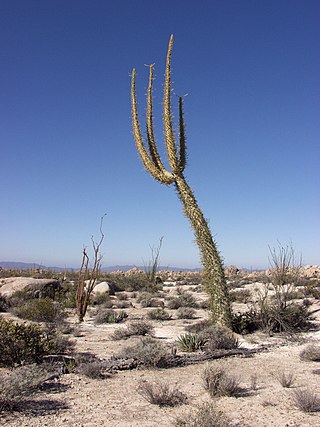
Fouquieria columnaris, the Boojum tree or cirio is a tree in the ocotillo family, whose other members include the ocotillos. Some taxonomists place it in the separate genus Idria. It is nearly endemic to the Baja California Peninsula, with only a small population in the Sierra Bacha of Sonora, Mexico. The plant's English name, Boojum, was given by Godfrey Sykes of the Desert Laboratory in Tucson, Arizona, and is taken from Lewis Carroll's poem "The Hunting of the Snark".
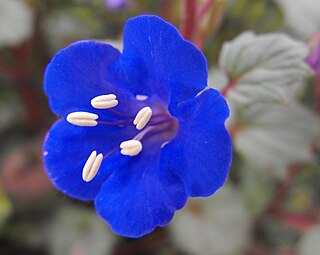
Phacelia campanularia is a species of flowering plant in the borage family, Boraginaceae, known by the common names desertbells, desert bluebells, California-bluebell, desert scorpionweed, and desert Canterbury bells. Its true native range is within the borders of California, in the Mojave and Sonoran Deserts, but it is commonly cultivated as an ornamental plant and it can be found growing elsewhere as an introduced species.

Eriastrum pluriflorum is a species of flowering plant in the phlox family known by the common names Tehachapi woollystar and many-flowered eriastrum.

Lycium andersonii is a species of flowering plant in the nightshade family, Solanaceae. Its common names include water-jacket, redberry desert-thorn, Anderson thornbush, Anderson's desert thorn, Anderson boxthorn, Anderson lycium, Anderson wolfberry, and squawberry.
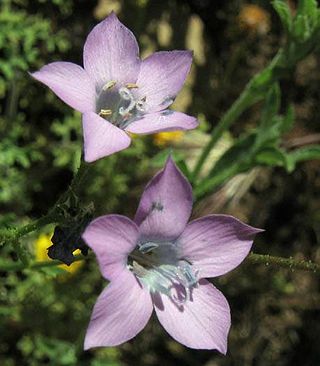
Saltugilia splendens, is a species of flowering plant in the phlox family known by the common names splendid woodland-gilia, Grinnell's gilia and splendid gilia.

Antirrhinum filipes is an annual species of North American snapdragon, usually known by the common name yellow twining snapdragon. This herbaceous plant is native to deserts of the southwestern United States and northern Mexico, where it is common.
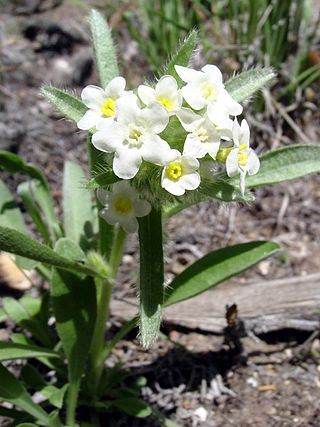
Greeneocharis circumscissa is a species of flowering plant in the borage family, known by the common name cushion cryptantha. It is native to western North America from Washington to Baja California to Colorado and it is also found in Argentina. It grows in sandy or gravelly types of habitat, from mountains to desert, below 9,500 m (31,200 ft) above sea level.
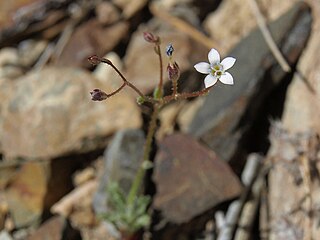
Gilia clokeyi is a species of flowering plant in the phlox family known by the common name Clokey's gilia. It is native to the south-western United States from California to Colorado, where it grows in desert and other habitat.

Linanthus maculatus is a species of flowering plant in the phlox family known by the common names San Bernardino Mountain gilia and Little San Bernardino Mountains gilia. It is endemic to California, where it is known only from a few locales in the Little San Bernardino Mountains and the adjacent Palm Springs area in the northern end of the Coachella Valley. The largest populations, which may contain thousands of individuals, are located within the bounds of Joshua Tree National Park. This is a very small annual herb no more than three centimeters high. It has a taproot which may exceed 6 centimeters in length to collect moisture from the dry desert sand in its native habitat. The tiny, hairy stem branches to form small matted clusters on the sand surface. The hairy leaves are just a few millimeters long and unlobed. The inflorescence is a dense cluster of flowers each only 2 to 5 millimeters wide. The flower corolla has curled-back lobes which are white, sometimes with a spot of purple or pink. The protruding stamens are yellow. The main threat to this species is development in its range, and it is also vulnerable to off-road vehicle damage in the wide open sandy flats where it grows.

Lycium brevipes is a species of flowering plant in the nightshade family known by the common name Baja desert-thorn. It is native to northwestern Mexico and it occurs in California as far as the Sonoran Desert as well as some of the Channel Islands. It grows in the scrub of desert and coastline. It is also used as a southwestern landscaping plant. This is a bushy, spreading shrub approaching a maximum height of 4 metres (13 ft) with many long, thorny, tangled branches. The branches are lined with small, fleshy green leaves up to 1.5 centimetres (0.59 in) long and coated with glandular hairs. The inflorescence is a small cluster of tubular flowers roughly 1–2 centimetres (0.39–0.79 in) long including the calyx of sepals at the base. The lavender to nearly white corolla is funnel-shaped and has 2 to 6 lobes at the mouth. The five stamens and one style protrude from the flower. The fruit is a bright red spherical berry about a centimeter wide containing many seeds. The berries attract birds.

Lycium cooperi is a species of flowering plant in the nightshade family known by the common name peach thorn. It is native to the southwestern United States, where it grows in a variety of desert and mountain habitat types. This is a bushy, erect shrub approaching a maximum height of 4 metres (13 ft) with many rigid, thorny branches. The branches are lined thickly with fleshy oval or widely lance-shaped leaves each 1–3 centimetres (0.39–1.18 in) long and coated with glandular hairs. The inflorescence is a small cluster of tubular flowers roughly 1–2 centimetres (0.39–0.79 in) long including the calyx of fleshy sepals at the base. The flower is white or greenish with lavender or green veining. The corolla is a tube opening into a face with four or five lobes. The fruit is a yellow or orange berry under a centimeter wide containing many seeds.
Nemacladus glanduliferus is a species of flowering plant in the bellflower family known by the common name glandular threadplant. It is native to the southwestern United States and Baja California, where it grows in desert and plateau habitat. It is an annual herb producing a purplish or brownish green, branching stem up to about 25 centimeters tall. Small oval leaves occur at the base of the plant. The inflorescence is a series of zigzagging branches bearing occasional flowers on thin, erect pedicels. There is a single small bract at the base of each pedicel. The flower at the curved tip of the pedicel is just a few millimeters wide. There are five pointed sepals and five white corolla lobes, generally three in the upper lip and two in the lower.

Psorothamnus schottii is a species of flowering plant in the legume family known by the common name Schott's dalea. It is native to the Sonoran Deserts of northern Mexico and adjacent sections of Arizona and the Colorado Desert in California.
Salvia greatae is a species of flowering plant in the mint family, Lamiaceae. Its common names include Orocopia sage and lavender sage.
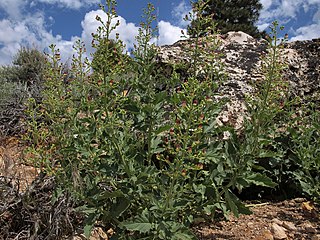
Scrophularia desertorum is a species of flowering plant in the figwort family known by the common name desert figwort. It is native to Nevada and eastern California where it grows in dry areas in local mountain ranges, including the Sierra Nevada and the desert ranges adjacent. It is a perennial herb producing clusters of erect stems that often exceed one meter tall. The leaves have toothed, triangular or lance-shaped blades up to 13 centimeters long which are borne on petioles measuring up to 10 centimeters in length. The inflorescence is a wide-open panicle with several hairy, glandular branches bearing flowers. The flower has a spherical corolla opening at the top into a hoodlike, lobed mouth. The corolla is just under a centimeter long and is whitish at the base and deep red around the mouth and on the lobes. The staminode is generally visible in the mouth of the corolla. The fruit is a capsule just under a centimeter long containing many seeds.

Symphoricarpos longiflorus is a species of flowering plant in the honeysuckle family known by the common names desert snowberry and fragrant snowberry. It is native to the western United States from the Great Basin to western Texas, as well as northwestern Mexico.
Teucrium glandulosum is a species of flowering plant in the mint family known by the common names sticky germander and desert germander. It is native to the Sonoran Desert of Arizona, Baja California, Baja California Sur, and San Bernardino County in California. It grows in rocky desert habitat such as canyons. The plant produces three-lobed leaves on its branching stem. The flowers have purple-streaked white corollas up to 2 centimeters long each with a large lower lobe and smaller lateral lobes. The inside of the flower is very hairy.
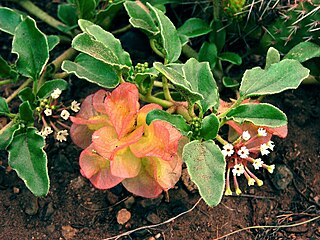
Tripterocalyx micranthus is a species of flowering plant in the four o'clock family known by the common names smallflower sandverbena and small-flowered sand-verbena.
Agave phillipsiana is a rare species of flowering plant in the asparagus family known by the common names Grand Canyon century plant and Phillips agave. It is endemic to Arizona in the United States, where it lives only in Grand Canyon National Park. It is a perennial herb or shrub.

Saltugilia is a genus of flowering plants in the phlox family, Polemoniaceae. They are known commonly as woodland gilias. There are four species. Two are endemic to California in the United States, and the distributions of the other two extend into Baja California in Mexico.

















